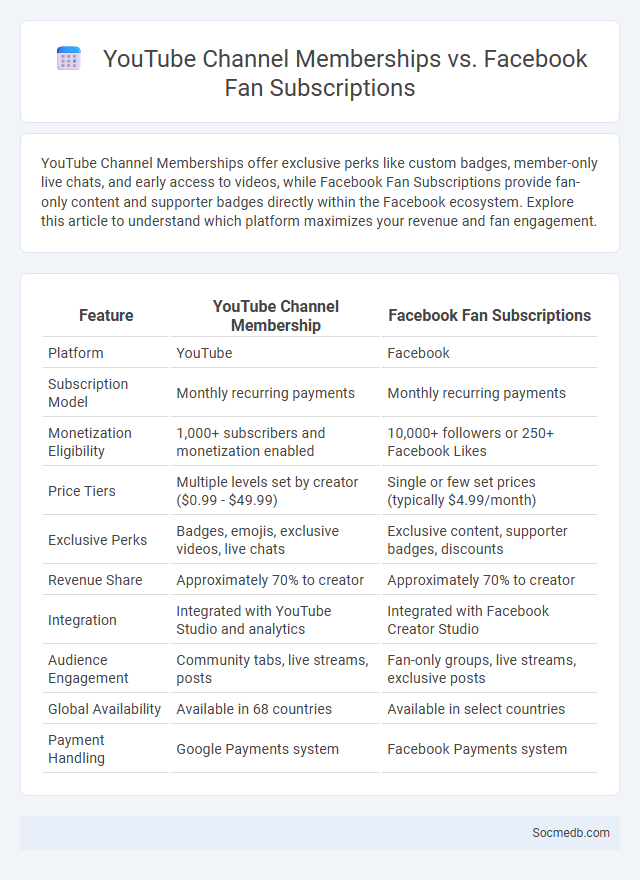
Photo illustration: YouTube Channel Membership vs Facebook Fan Subscriptions
YouTube Channel Memberships offer exclusive perks like custom badges, member-only live chats, and early access to videos, while Facebook Fan Subscriptions provide fan-only content and supporter badges directly within the Facebook ecosystem. Explore this article to understand which platform maximizes your revenue and fan engagement.
Table of Comparison
| Feature | YouTube Channel Membership | Facebook Fan Subscriptions |
|---|---|---|
| Platform | YouTube | |
| Subscription Model | Monthly recurring payments | Monthly recurring payments |
| Monetization Eligibility | 1,000+ subscribers and monetization enabled | 10,000+ followers or 250+ Facebook Likes |
| Price Tiers | Multiple levels set by creator ($0.99 - $49.99) | Single or few set prices (typically $4.99/month) |
| Exclusive Perks | Badges, emojis, exclusive videos, live chats | Exclusive content, supporter badges, discounts |
| Revenue Share | Approximately 70% to creator | Approximately 70% to creator |
| Integration | Integrated with YouTube Studio and analytics | Integrated with Facebook Creator Studio |
| Audience Engagement | Community tabs, live streams, posts | Fan-only groups, live streams, exclusive posts |
| Global Availability | Available in 68 countries | Available in select countries |
| Payment Handling | Google Payments system | Facebook Payments system |
Understanding YouTube Channel Membership
YouTube Channel Membership offers creators a powerful tool to generate recurring revenue by providing exclusive perks to subscribed members. Your audience gains access to custom badges, emojis, members-only videos, and live chat privileges, enhancing engagement and loyalty. Understanding the tiered membership options empowers you to tailor benefits that encourage viewers to support and grow your channel sustainably.
What Are Facebook Fan Subscriptions?
Facebook Fan Subscriptions are a monetization feature allowing creators to earn recurring revenue by offering exclusive content and perks to paying supporters. Subscribers gain access to unique badges, behind-the-scenes posts, and special interactions that deepen engagement between fans and creators. This tool empowers influencers, artists, and public figures to build sustainable income streams directly through their Facebook communities.
Channel Membership: Overview and Basics
Channel Membership is a monetization feature on social media platforms, primarily YouTube, enabling creators to offer exclusive content and perks to subscribers for a monthly fee. Members gain access to benefits like custom badges, emojis, early video releases, and members-only live chats, enhancing viewer engagement and loyalty. This feature supports creators in generating recurring revenue while building a dedicated community around their content.
Features Comparison: YouTube vs Facebook vs Channel Membership
YouTube offers channel memberships that provide exclusive perks like badges, emojis, and members-only content, enhancing direct supporter engagement. Facebook's equivalent features include subscription groups and fan subscriptions, which focus on community building and access to exclusive content for paying members. Your choice depends on the platform's audience, content format, and monetization goals, with YouTube excelling in video-based memberships and Facebook in social interaction and group exclusivity.
Monetization Opportunities and Payout Structures
Social media platforms offer diverse monetization opportunities including sponsored content, affiliate marketing, and direct consumer sales through integrated shop features. Payout structures vary widely, often based on engagement metrics such as views, clicks, or conversions, with platforms like YouTube using CPM (cost per mille) and TikTok implementing Creator Funds based on video performance. Understanding specific platform policies and optimizing content for algorithmic favorability are crucial for maximizing revenue streams and ensuring consistent payouts.
Membership Perks: Exclusive Content and Community Engagement
Membership perks on social media platforms include access to exclusive content such as behind-the-scenes videos, early releases, and member-only live streams that enhance user experience and engagement. Community engagement is fostered through members-only groups, interactive Q&A sessions, and direct communication with creators, increasing loyalty and retention. These benefits drive higher subscription rates and deepen connections between content creators and their audiences.
Audience Demographics and Platform Reach
Social media platforms exhibit diverse audience demographics, with Facebook leading among users aged 25-34 and TikTok dominating younger generations under 24. Instagram's visual-centric interface appeals primarily to millennials and Gen Z, while LinkedIn targets professionals aged 30-49, offering niche engagement for B2B marketing. Platform reach varies significantly, with Facebook boasting over 2.9 billion monthly active users, YouTube exceeding 2.6 billion, and Twitter maintaining a focused audience of approximately 450 million active users globally.
Setup Process and Requirements for Each Platform
Setting up your social media accounts requires understanding each platform's unique requirements, such as profile picture dimensions, username availability, and privacy settings. Instagram demands a mobile app for account creation, with a focus on visual content and bio customization, while LinkedIn emphasizes professional credentials and detailed work history. Facebook setup involves verifying an email or phone number, choosing page types for businesses or communities, and configuring audience targeting options for optimal engagement.
Marketing Strategies to Grow Channel Memberships
Targeted content marketing strategies that leverage user analytics and audience segmentation can significantly increase channel memberships on social media platforms. Engaging your audience through exclusive content, personalized offers, and interactive features like polls or live sessions fosters community loyalty and drives subscription growth. Optimize posting schedules and cross-promote across multiple channels to maximize reach and attract potential members.
Choosing the Best Platform for Your Content Monetization
Selecting the best platform for content monetization hinges on understanding the target audience demographics, engagement rates, and revenue models each social media site offers. Instagram excels in visual storytelling and influencer marketing with features like shoppable posts, while YouTube provides robust monetization through ad revenue, memberships, and super chats. TikTok's algorithm-driven content promotion and brand partnerships create viral potential, making it ideal for short-form videos and rapidly growing follower bases.
 socmedb.com
socmedb.com